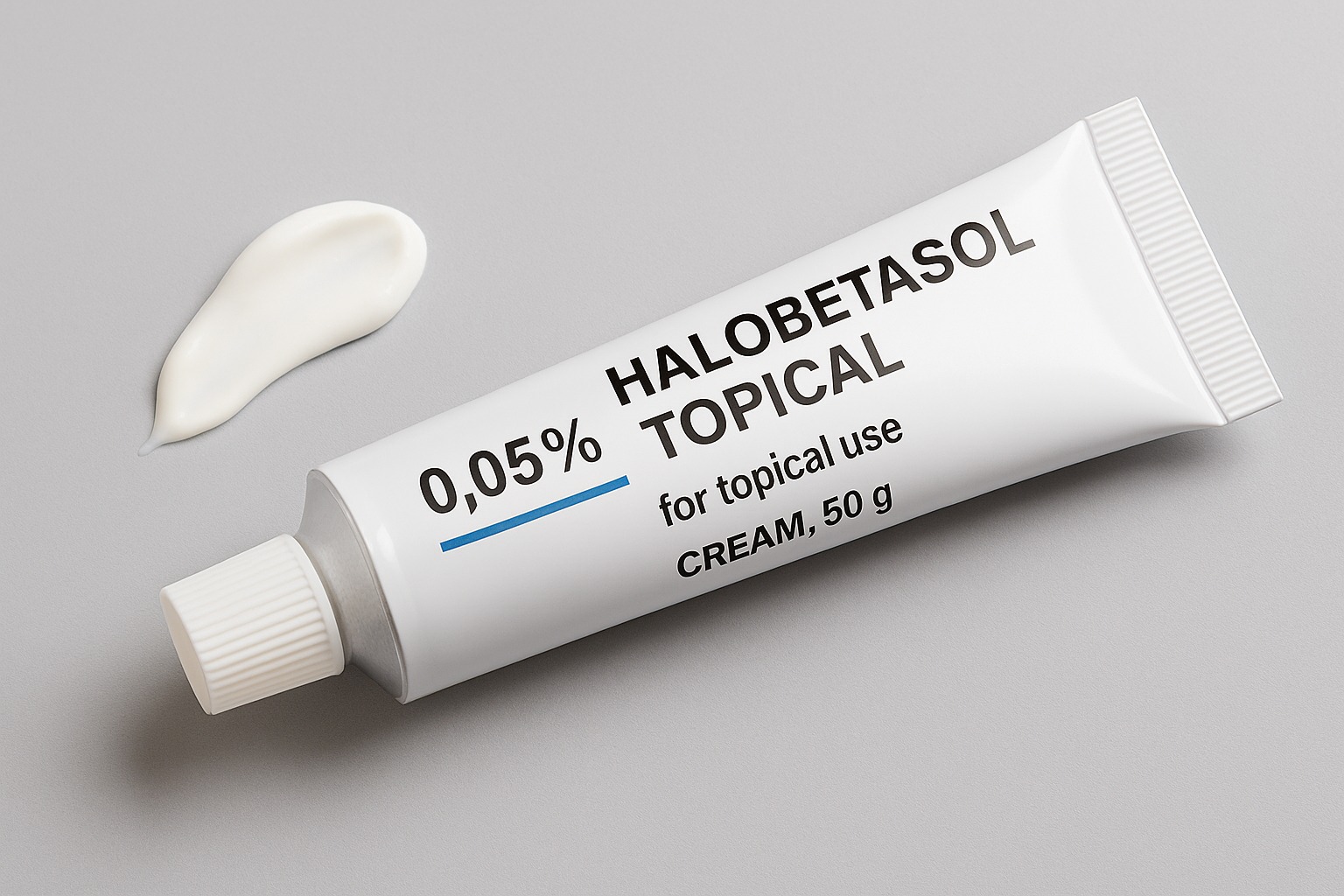Halobetasol topical is a prescription corticosteroid cream or ointment used to treat certain inflammatory skin conditions. It belongs to a class of medicines called super-potent topical steroids that help reduce redness, itching, and swelling. Doctors usually recommend it for short-term use when other, milder treatments are not effective.
In this easy-to-read guide, you’ll learn what Halobetasol topical is, how it works, when doctors prescribe it, how to apply it safely, possible side effects, precautions, and answers to some of the most common questions people search online.
Quick disclaimer: This article is for education only and not a substitute for professional medical advice. Always follow your dermatologist’s or healthcare provider’s instructions.
What Is Halobetasol Topical?
Halobetasol is a very strong corticosteroid medicine designed for use on the skin. It helps calm down the body’s immune response in areas where there is irritation or inflammation. Because of its high potency, doctors prescribe it only for certain skin problems and for a limited amount of time.
Halobetasol comes in these main forms:
- Halobetasol propionate cream 0.05%
- Halobetasol propionate ointment 0.05%
- Lotion, foam, or gel (in some regions)
These products are applied directly to the affected skin areas, usually once or twice a day.
How Does Halobetasol Work?
Skin conditions like eczema, psoriasis, or dermatitis cause the immune system to overreact, leading to redness, swelling, itching, and irritation.
Halobetasol works by:
- Suppressing the immune response in the treated skin area.
- Reducing swelling, redness, and itching.
- Helping the skin heal by calming inflammation.
Because it is stronger than many other topical steroids, Halobetasol can bring quick relief, but it must be used carefully to avoid side effects.
Common Uses of Halobetasol
Doctors prescribe Halobetasol topical for skin conditions that do not improve with weaker treatments. These include:
- Psoriasis (plaque type)
- Eczema (atopic dermatitis)
- Allergic or irritant contact dermatitis
- Lichen planus or lichen simplex chronicus
- Other steroid-responsive inflammatory skin problems
Important: It should not be used for acne, rosacea, or skin infections unless specifically directed by a doctor.
Dosage and Application
The way you use Halobetasol depends on your condition and doctor’s directions. General guidance:
- Amount: Apply a thin layer to the affected skin once or twice daily.
- Duration: Typically for up to 2 weeks. Longer use can increase risks.
- Avoid: Do not cover treated areas with bandages or tight dressings unless told by your doctor.
- Maximum dose: Usually not more than 50 grams per week.
Tips for safe application:
- Wash your hands before and after applying.
- Use a thin layer—more cream does not mean better results.
- Do not use on the face, groin, or underarms unless your doctor approves.
- Keep away from eyes, mouth, and open wounds.
Side Effects of Halobetasol
Like all medicines, Halobetasol can cause side effects. Some are mild and go away with time, while others may need medical attention.
Common side effects:
- Burning, stinging, or itching at the application site
- Dryness or irritation
- Skin thinning (if used too long)
- Stretch marks or changes in skin color
Serious side effects (rare, but seek medical help):
- Signs of infection (oozing, pus, worsening rash)
- Unusual tiredness, weight loss, or mood changes (possible systemic absorption if overused)
- Vision problems or eye irritation (if accidentally applied near eyes)
Always report new or worsening symptoms to your doctor early.
Warnings and Precautions
- Children: Not usually recommended in children under 12, as they are more sensitive to steroid side effects.
- Pregnancy & breastfeeding: Use only if clearly needed. Discuss with your doctor.
- Skin infections: Do not use on bacterial, viral, or fungal infections unless your doctor prescribes additional treatment.
- Long-term use: Can lead to skin thinning, easy bruising, or systemic steroid effects.
Halobetasol vs. Other Topical Steroids
- Strength: Halobetasol is among the strongest topical corticosteroids available.
- Duration: It is meant for short courses, while weaker steroids (like hydrocortisone) can often be used longer.
- Choice: Doctors select Halobetasol only when other options are not enough to control severe symptoms.
Proper Care While Using Halobetasol
- Follow your doctor’s instructions carefully.
- Do not share your medication with others.
- Avoid applying it to large areas of skin.
- Stop using it once your doctor advises—even if you still have some left in the tube.
Frequently Asked Questions (FAQs)
Q1. How long can I use Halobetasol topical?
Usually no longer than 2 weeks. Prolonged use can cause skin damage.
Q2. Can I use Halobetasol on my face?
Generally, no. The skin on your face is thin and more prone to side effects. Only use if your doctor says it is safe.
Q3. Is Halobetasol safe for children?
It is not typically recommended for children under 12 because of higher risks of side effects.
Q4. Can I use Halobetasol with moisturizers?
Yes. Apply the steroid first, wait a few minutes, and then use a moisturizer.
Q5. Does Halobetasol cure psoriasis or eczema?
No. It controls symptoms but does not cure the condition. Your doctor may combine it with other long-term treatments.
Final Thoughts
Halobetasol topical is a powerful corticosteroid that can bring fast relief from stubborn skin conditions like psoriasis and eczema. Because of its strength, it should only be used under close medical supervision and for short periods. When applied properly, it can help reduce itching, redness, and inflammation, improving comfort and quality of life.
Always follow your doctor’s instructions, use it safely, and report any unusual changes in your skin.


Leave a Comment